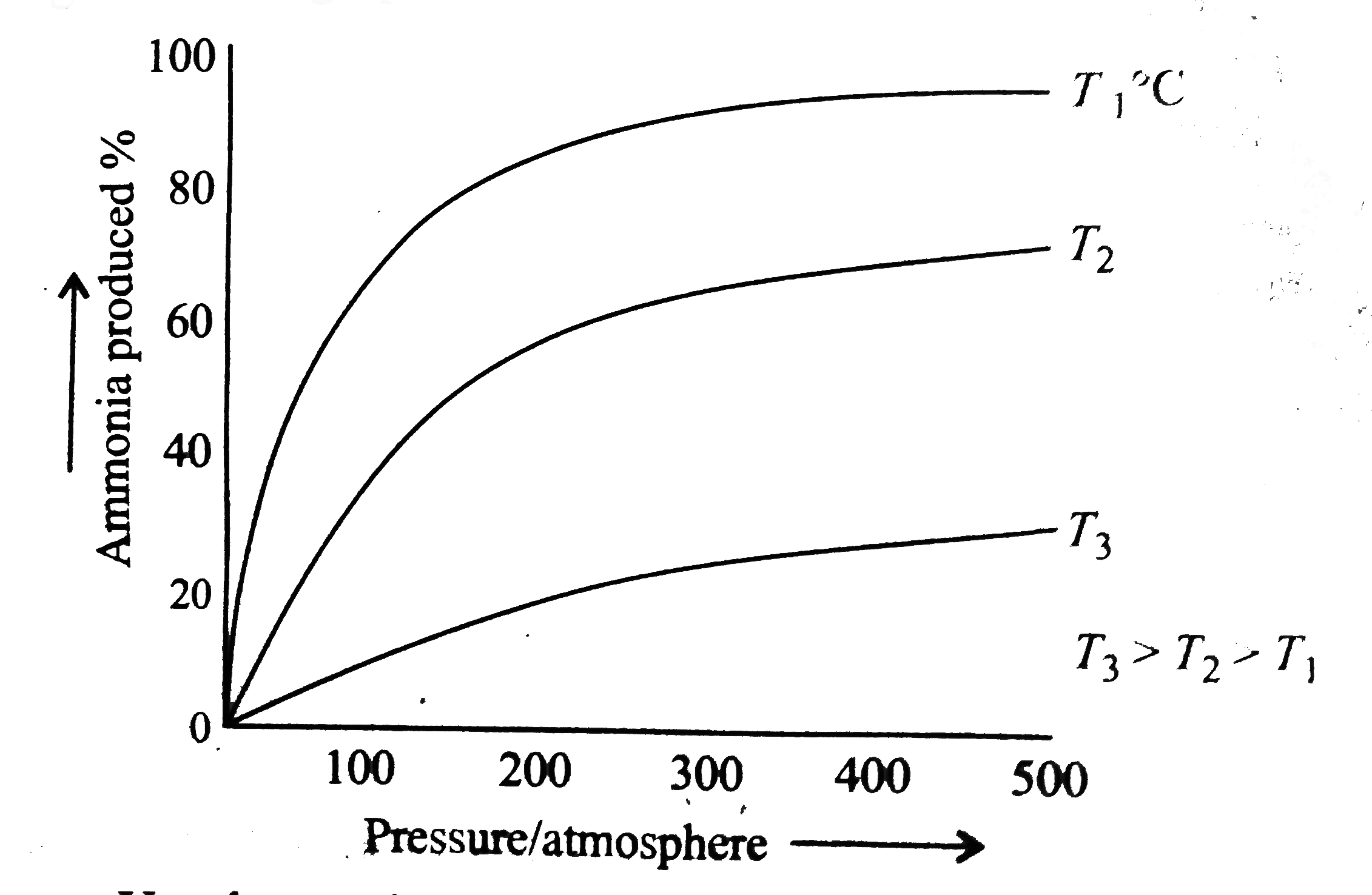In the industrial preparation of ammonia by Haber process from nitrogen and hydrogen, the reaction is carried in the temperature range of 450∘C to 500∘C and in a pressure range of 200 atm to 300 atm. Now answer the following question.
How is ammonia separated from unreacted nitrogen and hydrogen?
To separate ammonia from unreacted nitrogen and hydrogen in the industrial preparation of ammonia by the Haber process, follow these steps:
1. Understanding the Reaction: The Haber process involves the reaction of nitrogen (N₂) and hydrogen (H₂) to produce ammonia (NH₃). The reaction is represented as:
N2(g)+3H2(g)⇌2NH3(g)
This reaction occurs under high temperature (450°C to 500°C) and high pressure (200 atm to 300 atm).
2. Cooling the Reaction Mixture: After the reaction is complete, the resulting mixture contains unreacted nitrogen, hydrogen, and ammonia gas. To separate ammonia, the first step is to cool the reaction mixture. Cooling reduces the temperature of the gases.
3. Condensation of Ammonia: As the mixture is cooled, ammonia gas condenses into a liquid due to its higher boiling point compared to nitrogen and hydrogen. The boiling point of ammonia is -33.34°C, while nitrogen and hydrogen remain in the gaseous state at these temperatures.
4. Separation of Liquid Ammonia: Once ammonia has condensed into a liquid, it can be separated from the unreacted gases. This can be achieved using various methods, such as using a separator or a distillation column, where the liquid ammonia is collected and the unreacted nitrogen and hydrogen gases are left behind.
5. Removal of Unreacted Gases: The unreacted nitrogen and hydrogen can be recycled back into the reaction chamber to be reused in the process, ensuring efficient use of raw materials.
Final Answer:
Ammonia is separated from unreacted nitrogen and hydrogen by cooling the reaction mixture to condense ammonia into a liquid state, which is then collected and separated from the remaining gases.
---
N2(g)+3H2(g)⇌2NH3(g)
This reaction occurs under high temperature (450°C to 500°C) and high pressure (200 atm to 300 atm).
Ammonia is separated from unreacted nitrogen and hydrogen by cooling the reaction mixture to condense ammonia into a liquid state, which is then collected and separated from the remaining gases.
Topper's Solved these Questions
- MOLE CONCEPT & STOICHIOMETRY (PART-A GAY LUSSAC'S LAW - AVOGADRO'S LAW-MOLE CONCEPT)Book:ICSEChapter: MOLE CONCEPT & STOICHIOMETRY (PART-A GAY LUSSAC'S LAW - AVOGADRO'S LAW-MOLE CONCEPT)Exercise:Problems based on Mole Concept & Avogadro.s Number
Explore 13 Videos
- MOLE CONCEPT & STOICHIOMETRY (PART-A GAY LUSSAC'S LAW - AVOGADRO'S LAW-MOLE CONCEPT)Book:ICSEChapter: MOLE CONCEPT & STOICHIOMETRY (PART-A GAY LUSSAC'S LAW - AVOGADRO'S LAW-MOLE CONCEPT)Exercise:Problems based on Mole Concept & Avogadro.s Law
Explore 2 Videos
- ACIDS, BASES AND SALTSBook:ICSEChapter:ACIDS, BASES AND SALTSExercise:Unit Test Paper 3A- Acids, Bases & Salts
Explore 14 Videos
Similar Questions
In the industrial preparation of ammonia by Haber process from nitrogen and hydrogen, the reaction is carried in the temperature range of 450∘C to 500∘C and in a pressure range of 200 atm to 300 atm. Now answer the following question.
What is the name of the catalyst used in the reaction?
View SolutionIn the industrial preparation of ammonia by Haber process from nitrogen and hydrogen, the reaction is carried in the temperature range of 450∘C to 500∘C and in a pressure range of 200 atm to 300 atm. Now answer the following question.
The reaction is not carried at very high pressure. Give one reason.
View SolutionIn the industrial preparation of ammonia by Haber process from nitrogen and hydrogen, the reaction is carried in the temperature range of 450∘C to 500∘C and in a pressure range of 200 atm to 300 atm. Now answer the following question.
The reaction is not carried out at a lower temperature. Give one reason.
View SolutionThe process by which ammonia is formed from nitrogen and hydrogen is
View SolutionThe process by which ammonia is formed from nitrogen and hydrogen is
View SolutionThe persentage of ammonia produced from nitrogen and hydrogen under conditions of temperature and pressure is given in the graph

Use the graph answering the following questions:
What happens to the percentage of ammonia produced when the pressure is increased?
View SolutionThe persentage of ammonia produced from nitrogen and hydrogen under conditions of temperature and pressure is given in the graph

Use the graph answering the following questions:
What happens to the percentage of ammonia produced when the temperature is increased
View SolutionThe persentage of ammonia produced from nitrogen and hydrogen under conditions of temperature and pressure is given in the graph

Use the graph answering the following questions:
What conditions of pressure produce the highest percentage of ammonia?
View SolutionHow many litres of ammonia gas will be produced when one litre of nitrogen combines with three litres of hydrogen at a given temperature and pressure?
View SolutionWhat will be the final pressure of an ideal gas present in a cylinder at 2 atm when the temperature of the gas is increased from 100∘C to 500∘C?
View Solution

